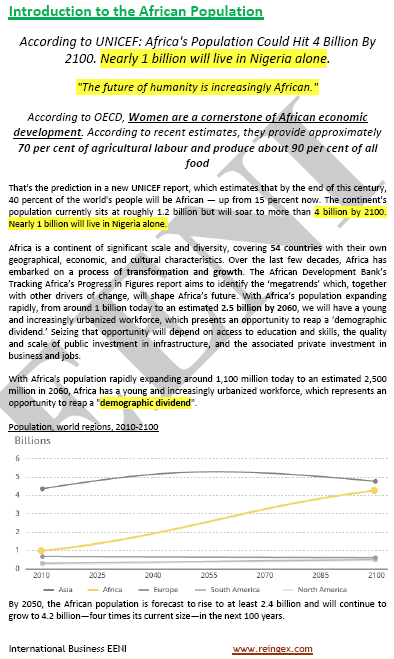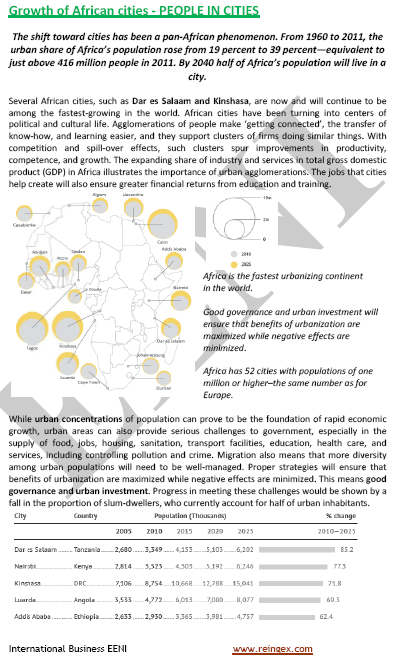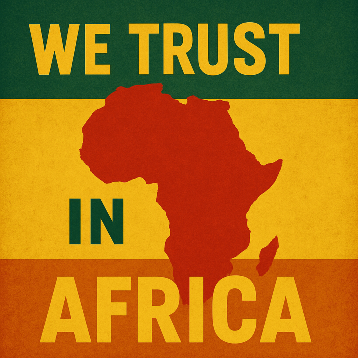
Future of humanity is ever more African
African population in 2100: 4,000 million. Nigeria: 1,000. Trends
“The future of humanity is ever more African” (UNICEF).
- Trends in the African Population
- Comparison between the African and World population
- African Cities Growth
- Tracking African Progress in Figures (African Development Bank)
- Life expectancy and mortality
- Health and Education in Africa
- Generation 2030: Child demographics in Africa (UNICEF)
- Child, adolescent, working-age and elderly populations in Africa
- Trends in Births in Africa (By 2030: 33% of the Global births)
- Density and urbanization in Africa
- Fragility and poverty in Africa
- Demographic transition of Africa

The Subject “Trends in the African Population” belongs to the following Online Programs taught by EENI Global Business School:
Doctorate in African Business.
Master in Business in Africa, Transport in Africa.

EENI Partnerships with Educational Institutions
Languages:  or
or  Afrique
Afrique
 População africana
População africana  Población africana.
Población africana.

Sample - Trends in the African Population (African Civilization):

The Human capital will be the main driver of the economic growth in Africa, an opportunity to obtain a “demographic dividend.”
Total African population: 1,037,694,509 inhabitants.
- Male: 518,636,010
- Female: 519,058,499
Women are one of the pillars of the African economic development:
- 70% percent of the agricultural labour
- According to the OECD, the African Women produce 90% of all food
Africa will lead the World's population growth over the next fifty years.
Mega - African cities: 50% of the African population will live in a town (2040).

In thirty-five years, 25% of the world's population will be African.
Country/Population (Normalized, 2015).
Nigeria: 185,043,000
Ethiopia: 90,076,000
Egypt: 88,523,000
Democratic Republic of the Congo: 71,246,000
South Africa: 54,844,000
Tanzania: 48,829,000
Kenya: 44,153,000
Algeria: 39,903,000
Sudan: 38,435,000
Uganda: 35,760,000
Morocco: 33,656,000
Ghana: 27,714,000
Mozambique: 25,728,000
Angola: 25,326,000
Ivory Coast: 25,302,000
Madagascar: 23,053,000
Cameroon: 21,918,000
Niger: 18,880,000
Burkina Faso: 18,477,000
Mali: 17,796,000
Malawi: 16,307,000
Zambia: 15,474,000
Senegal: 14,150,000
Chad: 13,675,000
Zimbabwe: 13,503,000
South Sudan: 12,519,000
Rwanda: 11,324,000
Tunisia: 11,118,000
Somalia: 10,972,000
Guinea: 10,935,000
Benin: 10,750,000
Burundi: 9,824,000
Togo: 7,065,000
Eritrea: 6,895,000
Libya: 6,521,000
Sierra Leone: 6,513,000
The Central African Republic: 5,545,000
Republic of the Congo: 4,706,000
Liberia: 4,046,000
Mauritania: 3,632,000
Gabon: 2,382,000
Namibia: 2,233,000
Botswana: 2,176,000
Gambia: 2,022,000
Equatorial Guinea: 1,996,000
Lesotho: 1,908,000
Guinea-Bissau: 1,788,000
Mauritius: 1,263,000
Eswatini: 1,097,000
Djibouti: 961,000
Comoros: 783,000
Arab Republic Saharaui Democratic: 656,000
Cape Verde: 525,000
São Tomé and Príncipe: 194,000
Seychelles: 97,000
Total Africa: 1,151,303,000

(c) EENI Global Business School (1995-2024)
We do not use cookies
Top of this page



